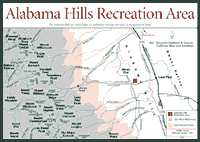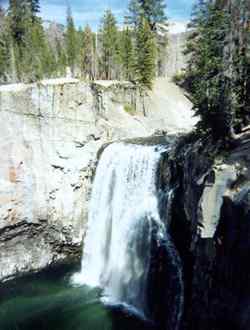 Alabama
Hills Recreation Area
Alabama
Hills Recreation Area  Alabama
Hills Recreation Area
Alabama
Hills Recreation Area [Fig. 43(1)] These hills at the foot of the stunning eastern escarpment provide views, history, and interesting geology for visitors. To the west of this 30,000-acre area, managed by the U.S. Bureau of Land Management, Mount Whitney and a few other wind-whipped 14,000-foot peaks stand high above the Alabamas, creating striking photographic opportunities for visitors.
The Alabama Hills have been an attraction for prospectors in the nineteenth century, Native Americans, and filmmakers. The first two groups are not too unusual for the Eastern Sierra, but Hollywood filmmakers are not generally interested in this part of California unless they're shooting a western.
Since the early 1920s, the Alabamas have been the backdrop for such western characters as Tom Mix, Hopalong Cassidy, Gene Autry and the Lone Ranger. Film classics such as Gunga Din, Springfield Rifle, and How the West Was Won were filmed at sites now known as "Movie Flats" and Movie Flat Road in the Alabama Hills. Some of Mel Gibson's scenes in the movie Maverick also were shot here.
Television advertisements shot in the Alabama Hills have had such sponsors as Reebok, Nissan, Eveready Battery Company, Saab, Mazda, and Jeep-Eagle. Filmmakers like the wide-open look of the Eastern Sierra and dramatic background provided by the Sierra.
But the Alabama Hills also offer a very distinctive appearance. The rounded, weathered Alabamas look as though they were transported from another place, in contrast with sculptured ridges of the Sierra. But the same cataclysmic uplifting in the Sierra batholith 100 million years ago shaped both features.
Over the millennia, wind-blown sand has blasted across the Alabamas and helped create the cracked, weathered granite. Geologists believe the weathering occurred during a time when the Eastern Sierra climate was moister than it is now. The rock was covered with soil, and moisture worked its way into the granite. The moisture and the soil chemically combined to erode the granite, geologists think. As the climate dried out, the wind slowly stripped away the soil from around the granite.
The name, Alabama Hills, comes from a Confederate warship responsible for wreaking havoc on union shipping during the Civil War. Prospectors who were sympathetic to the Confederate cause named their mining claims after the Alabama and eventually the name stuck to these hills.
The warship Alabama was both brilliant and short lived. Yankee warships cornered the Alabama and sank it in a running gun battle. The Northern steam-sail ship, U.S.S. Kearsarge sank the Alabama in the Atlantic Ocean during the summer of 1864. Miners who sympathized with the North in the Civil War indulged in "one-up-manship," by naming a whole mining district, a mountain pass, a peak, and a town "Kearsarge." Those names are still part of the Eastern Sierra as well.
In the arid hills, wildflowers bloom earlier in the season—May and June—than in the higher Sierra elevations. For anyone driving along Highway 395 on the long stretch between Los Angeles and Lake Tahoe, a short stop in spring will be rewarding. The more common and attractive wildflowers include prairie smoke (Geum ciliatum), low evening primrose (Oenothera caespitosa), lowly penstemon (Penstemon humilis), and desert paintbrush (Castilleja chromosa).
The pinion pine (Pinus monophylla) dominates the woodland areas in this part of the Eastern Sierra. Understory vegetation includes basin wild rye (Elymus cinereus) and Idaho fescue (Festuca idahoensis). Also, look for shrubs, such as western chokecherry (Prunus demissa) and spiny hopsage (Grayia spinosa).
To survive in this arid climate, shrubs must send down large taproots or large systems of spreading roots to take advantage of any moisture available. Visitors may notice the hairiness on some of the shrubs, such as winter fat (Ceratoides lanata). It is another adaptation to this area. The hairs reflect sunlight and lower the temperature of the plant in desert conditions. The reflected light gives many of these plants the pastel or light colors associated with the area. The hairs also offer protection and insulation from the heat and the wind.
 The
animals of this area are also interesting. They include the Merriam's shrew
(Sorex merriami), Great Basin kangaroo rat (Dipodomys microps),
and southern grasshopper mouse (Onychomys torridus).
The
animals of this area are also interesting. They include the Merriam's shrew
(Sorex merriami), Great Basin kangaroo rat (Dipodomys microps),
and southern grasshopper mouse (Onychomys torridus).
Visitors might encounter the speckled rattlesnake (Crotalus mitchelli), though the snake avoids human contact at all costs and bites only in self-defense. The heat-sensing pits on this snake's snout help it find warm-blooded prey. It can be found below boulders in this area. Watch your step.
Another interesting creature is the sage grouse (Centrocercus urophasianus), a bird with a distinctive ritual to determine which male will be the "master cock" during mating. The birds will gather in an open area during spring to strut and reveal their plumage, often having mock battles. A hierarchy develops and a single male emerges with a few others serving as guards against the unsuccessful males attempting to mate with the female population.
The Alabama Hills are laced with trails and dirt access roads for people to hike and climb to see the sights. But there are mine shafts and tunnels in the area, and they could be dangerous. False bottoms might give way or tunnels collapse because of deterioration of the timbers that support the tunnels.
Read and add comments about this page